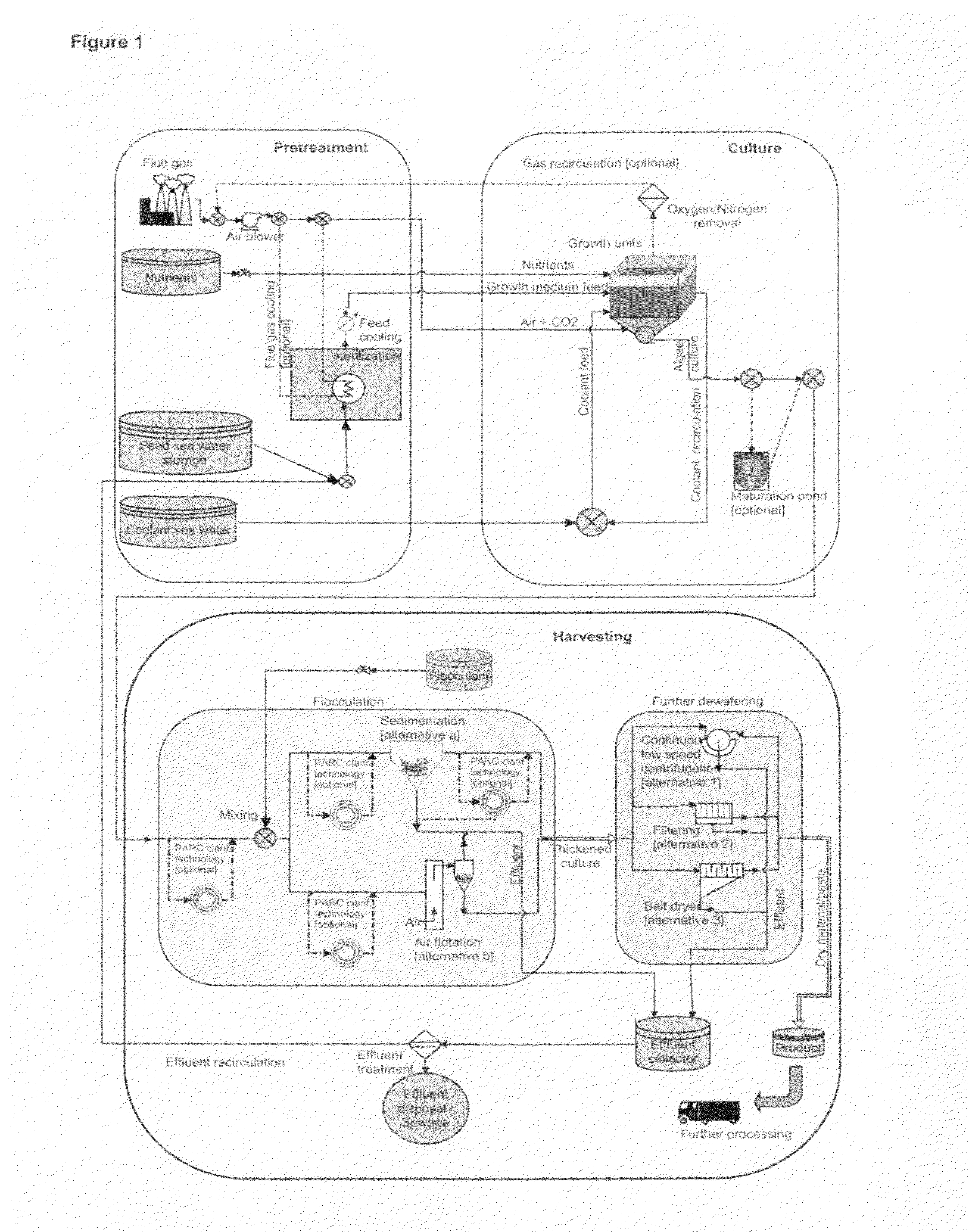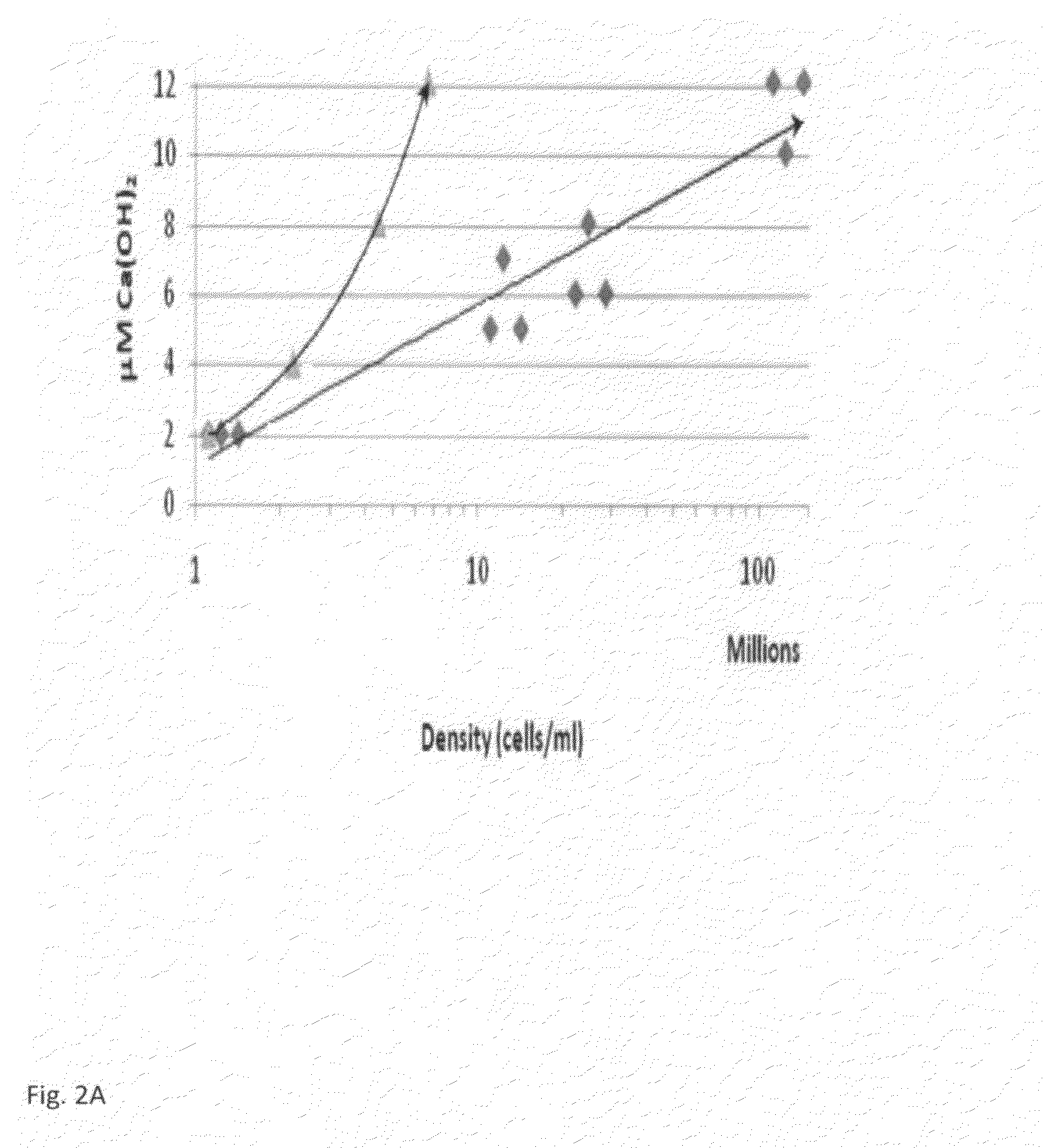Method and system for efficient harvesting of microalgae and cyanobacteria
a technology of cyanobacteria and microalgae, which is applied in the field of harvesting microalgae and cyanobacteria, can solve the problems of inefficiency and high cost of centrifugation required to separate microalgae, major challenge to the use of microalgae, and flocculation has been considered too expensive as a harvesting mechanism of algae, and achieves small differences in results. , the effect of affecting the efficacy
- Summary
- Abstract
- Description
- Claims
- Application Information
AI Technical Summary
Benefits of technology
Problems solved by technology
Method used
Image
Examples
example 1
Algal and Cyanobacterial Flocculation
[0049]This example describes a method of algae harvest technique by induced cell flocculation.
Materials and Methods
Algal Cultivation:
[0050]Algae were cultured indoors in 2 L polyethylene (P.E) tubes. A constant temperature regime was maintained at 23° C., light:dark was set at 16:8 firs, light intensity of 100 μmol photons m−2 s−1. Marine species were cultured in filtered seawater; F / 2 nutrient enrichment (Guillard and Ryther, 1962) was added every 72 hours at a dosage of 1:1000. Chlamydomonas reinhardtii was cultured in TAP culture medium (Gorman D. S. and R. P. Levine, 1965. P. Natl. Acad. Sci, USA 54: 1665-1669). Synechococcus 7942 was cultured in BG11 culture medium. Cultures were mixed by aeration. CO2 was mixed with air and delivered to the cultures at controlled ratios via the aeration system.
Time of Harvest:
[0051]Algae were harvested for experiments near their maximal culture densities.
Method of Adding Alkali:
[0052]Alkali was added to 15 ...
example 2
Effect of Culture Density on the Amount of Flocculant Needed to Induce Flocculation
[0057]The amount of flocculant needed to induce flocculation can affect the operating cost of algae harvesting systems. To this end we tested the effect of algal suspension density on the amount of Ca(OH)2 needed to induce flocculation, demonstrating that flocculation was a function of the logarithm of the cell density and not a linear function of cell density, as had been previously thought.
Materials and Methods
[0058]In order to test the relationship between algae density and the amount of flocculant needed to cause flocculation, cell suspensions cultured as described above were diluted with filtered seawater. Assays were run simultaneously on the initial and diluted suspensions. pH was measured and flocculation was induced and determined as described in Example 1.
[0059]The results of this example are shown in FIG. 2. The 0.9 R2 value presented in FIG. 2 indicates that the amount of Ca(OH)2 needed to...
example 3
Effect of Culture Density on the pH Value at the Onset of Flocculation
[0060]In order to compare our methodology with previously reported studies we tested the effect of algal suspension density on the pH value measured at flocculation.
Materials and Methods
[0061]In order to test the effect of algae density on the pH value of culture media at the onset of flocculation (pHf), cell suspensions cultured as describe above were diluted with filtered seawater. Assays were run simultaneously on the source and diluted suspensions. pH was measured by a pH electrode (Pasco Scientific, Roseville, Calif.) using DataStudio software. Flocculation was induced and determined as described above, at which point pH was recorded.
[0062]Results of this example are shown in FIG. 3.
[0063]The R squared values presented in FIG. 3 indicate that the pHf value is a function of the logarithm of the cell density, but the actual effect is greater for Isochrysis sp. CS-177 than for Nannochloropsis salina. Therefore w...
PUM
| Property | Measurement | Unit |
|---|---|---|
| pH | aaaaa | aaaaa |
| pH | aaaaa | aaaaa |
| pH | aaaaa | aaaaa |
Abstract
Description
Claims
Application Information
 Login to View More
Login to View More - R&D
- Intellectual Property
- Life Sciences
- Materials
- Tech Scout
- Unparalleled Data Quality
- Higher Quality Content
- 60% Fewer Hallucinations
Browse by: Latest US Patents, China's latest patents, Technical Efficacy Thesaurus, Application Domain, Technology Topic, Popular Technical Reports.
© 2025 PatSnap. All rights reserved.Legal|Privacy policy|Modern Slavery Act Transparency Statement|Sitemap|About US| Contact US: help@patsnap.com



